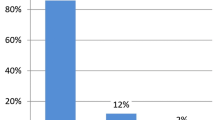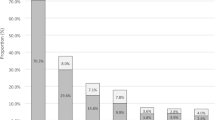Abstract
This study qualitatively explored the impact of gambling advertising on problem gambling by interviewing twenty-five people with current or past gambling problems. Interviews were relatively long and involved the participants’ viewing numerous examples of gambling advertising. A quarter of the participants reported that gambling advertising had no impact on their problems, slightly over half of them reported that advertising had a marginal impact, and one fifth reported a tangible impact. However, none considered advertising to be a main cause of their gambling problems. The negative self-perceived impact was primarily that advertising triggered impulses to gamble. Advertising thus increased already high involvement in gambling and/or made it harder to stick to a decision to gamble less or not at all.
Similar content being viewed by others
References
American Psychiatric Association (1994). Diagnostic and statistical manual of mental disorders (4th ed.). Washington, DC: American Psychiatric Association.
Amey, B. (2001). People’s participation in and attitudes to gaming, 1985–2000: Final results of the 2000 survey. Wellington: Department of Internal Affairs.
Binde, P. (2005). Att sälja en dröm: Om spelreklam och dess påverkan. Stockholm: Statens folkhälsoinstitut.
Binde, P. (2007a). Selling dreams—causing nightmares? On gambling advertising and problem gambling. Journal of Gambling Issues, 20, 167–192.
Binde, P. (2007b). Spelreklam och spelberoende: En intervjustudie. Östersund: Statens folkhälsoinstitut.
Bonke, J. (2007). Ludomani i Danmark II: Faktorer af betydning for spilleproblemer. København: Socialforskningsinstituttet.
Boughton, R., Brewster, J. M. (2002). Voices of women who gamble in Ontario: A survey of women’s gambling, barriers to treatment and treatment service needs. Retrieved October 12, 2008, from http://www.gamblingresearch.org/download.sz/voicesofwomen%20Boughton%20(1).pdf?docid=1524.
Brown, R. I. F. (1988). Models of gambling and gambling addictions as perceptual filters. Journal of Gambling Behavior, 3(4), 224–236. doi:10.1007/BF01019882.
Carlson, M. J., & Moore, T. L. (1998). Adolescent gambling in Oregon: A report to the Oregon Gambling Addiction Treatment Foundation. Salem, ON: Oregon Gambling Addiction Treatment Foundation.
Clotfelter, C. T., & Cook, P. J. (1989). Selling hope: State lotteries in America. Cambridge, MA: Harvard University Press.
Crockford, D. N., Goodyear, B., Edwards, J., Quickfall, J., & el-Guebaly, N. (2005). Cue-induced brain activity in pathological gamblers. Biological Psychiatry, 58(10), 787–795. doi:10.1016/j.biopsych.2005.04.037.
Drummond, D. C., & Glautier, S. (1994). A controlled trial of cue exposure treatment in alcohol dependence. Journal of Consulting Clinical Psychology, 62(4), 809–817. doi:10.1037/0022-006X.62.4.809.
Gambling Impact and Behavior Study (1999). Report to the National Gambling Impact Study Commission. Chicago, IL: National Opinion Research Center at the University of Chicago.
Gehring, V. V. (1999). The American state lottery: Sale or swindle? International Journal of Applied Philosolophy, 13(2).
Goudriaan, A. E., Oosterlaan, J., de Beurs, E., & Van den Brink, W. (2004). Pathological gambling: A comprehensive review of biobehavioral findings. Neuroscience & Biobehavioral Reviews, 28(2), 123–141. doi:10.1016/j.neubiorev.2004.03.001.
Grant, J. E., & Kim, S. W. (2001). Demographic and clinical features of 131 adult pathological gamblers. Journal of Clinical Psychiatry, 62(12), 957–962.
Griffiths, M. D. (2005). Does gambling advertising contribute to problem gambling? International Journal of Mental Health and Addiction, 3(2), 15–25.
Haracz, J. L., Mash, D. C., & Sircar, R. (1999). A multicomponent learning model of drug abuse: Drug taking and craving may involve separate brain circuits underlying instrumental and classical conditioning, respectively. Annals of New York Academy of Sciences, 877, 811–819. doi:10.1111/j.1749-6632.1999.tb09329.x.
Heath, R. (2000). Low involvement processing—a new model of brands and advertising. International Journal of Advertising, 19(3), 287–298.
Heath, R., Brandt, D., & Nairn, A. (2006). Brand relationships: Strengthened by emotion, weakened by attention. Journal of Advertising Ressearch, 46(4), 410–419. doi:10.2501/S002184990606048X.
Jones, M. J. (2001). Odds should improve for lottery advertising guidelines. Gaming Law Review, 5(3), 161–163. doi:10.1089/10921880152486843.
Jonsson, J., Andrén, A., Nilsson, T., Svensson, O., Munck, I., Kindstedt, A., et al. (2003). Spelberoende i Sverige—vad kännetecknar personer med spelproblem? Rapport om andra fasen av den svenska nationella studien av spel och spelberoende. Stockholm: Statens folkhälsoinstitut.
Korn, D., Hurson, T., & Reynolds, J. (2003). Commercial gambling advertising: Possible impact on youth knowledge, attitudes, beliefs and behavioural intentions. Guelph: Ontario Problem Gambling Research Centre. Retrieved October 12, 2008, from: http://www.gamblingresearch.org/download.sz/125%20Final%20Report%20-%2012APR05.pdf?docid=6481.
Lee, H.-S., Lee Lemanski, J., & Jun, J. W. (2008). Role of gambling media exposure in influencing trajectories among college students. Journal of Gambling Studies, 24(1), 25–37. doi:10.1007/s10899-007-9078-0.
Lesieur, H. R., & Blume, S. B. (1987). The South Oaks Gambling Screen (SOGS): A new instrument for the identification of pathological gamblers. American Journal of Psychiatry, 144(9), 1184–1188.
Lund, I. (2008). The population mean and the proportion of frequent gamblers: Is the theory of total consumption valid for gambling? Journal of Gambling Studies, 24(2), 247–256. doi:10.1007/s10899-007-9081-5.
Miller, R., & Mizerski, R. (1998). Investigating the relationship between ad recall, affect toward the producer and the purchase of three number lotto tickets (work in progress). Paper presented at the ANZMAC98 Conference, Otago, New Zealand, November 30–December 2, 1998. Retreived October 12, 2008, from: http://130.195.95.71:8081/www/ANZMAC1998/Cd_rom/Miller268.pdf.
Oakes, J., Battersby, M. W., Pols, R. G., & Cromarty, P. (2008). Exposure therapy for problem gambling via videoconferencing: A case report. Journal of Gambling Studies, 24(1), 107–118. doi:10.1007/s10899-007-9074-4.
Potenza, M. N., Steinberg, M. A., Skudlarski, P., Fulbright, R. K., Lacadie, C. M., Wilber, M. K., et al. (2003). Gambling urges in pathological gambling. Archives of General Psychiatry, 60(8), 828–836. doi:10.1001/archpsyc.60.8.828.
Poulin, C. (2006). Gambling. Canadian Medical Association Journal, 175(10), 1208–1209. doi:10.1503/cmaj.061299.
Rönnberg, S., Volberg, R. A., Abbott, M. W., Moore, W. L., Andrén, A., Munck, I., et al. (1999). Gambling and problem gambling in Sweden. Stockholm: Statens folkhälsoinstitut.
Shenk, J. W. (1995). Everyone’s a loser: How lottery ads entice the wrong people to gamble. The Washington Monthly, 27(7/8), 22–25.
Stranahan, H., & O’Malley Borg, M. (1998). Horizontal equity implications of the lottery tax. National Tax Journal, 51(1), 71–82.
Symes, B. A., & Nicki, R. M. (1997). A preliminary consideration of cue-exposure, response-prevention treatment for pathological gambling behaviour: Two case studies. Journal of Gambling Studies, 13(2), 145–157. doi:10.1023/A:1024951301959.
Tavares, H., Zilberman, M. L., Hodgins, D. C., & el-Guebaly, N. (2005). Comparison of craving between pathological gamblers and alcoholics. Alcoholism: Clinical & Experimental Research, 29(8), 1427–1431. doi:10.1097/01.alc.0000175071.22872.98.
Acknowledgements
This research has been funded by the Swedish National Institute of Public Health. Some of the arguments have appeared in Swedish in the report Spelreklam och spelberoende: En intervjustudie (Binde 2007b). The paper was presented at the European Association for the Study of Gambling (EASG) conference in Nova Gorizia, Slovenia, 1–4 July 2008. I am thankful for comments received on that occasion.
Author information
Authors and Affiliations
Corresponding author
Rights and permissions
About this article
Cite this article
Binde, P. Exploring the Impact of Gambling Advertising: An Interview Study of Problem Gamblers. Int J Ment Health Addiction 7, 541–554 (2009). https://doi.org/10.1007/s11469-008-9186-9
Received:
Accepted:
Published:
Issue Date:
DOI: https://doi.org/10.1007/s11469-008-9186-9




